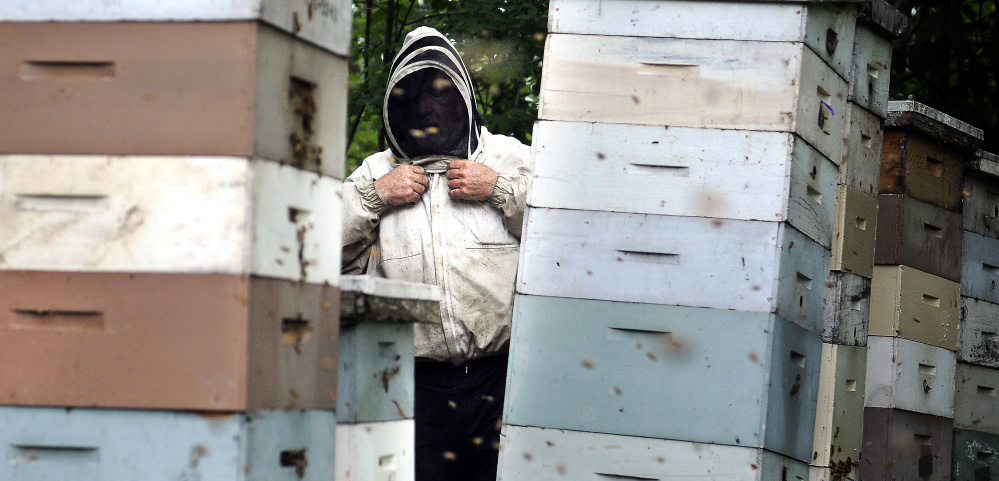If you talk to 10 beekeepers, you’ll come back with 12 different opinions.
That’s what Doug Calhoun will tell you if you ask to talk about the state’s official insect, the honeybee. Calhoun helps run the Waldo County branch of the Maine State Beekeepers Association.
And while more than one veteran beekeeper says there are increasing challenges in beekeeping now, the number of licensed beekeepers in the state has been growing every year.
In 2013, Maine had 874 beekeepers; in 2014, 944; and in 2015, 990. So far in 2016, the state has 959 licensed beekeepers.
But the same can’t be said of the honeybees themselves. From 1990 to 2004, managed populations of honeybees have decreased by 25 percent, according to a fact sheet published by the cooperative extension at the University of Maine.
“There’s a problem with all pollinators,” Calhoun said last week. “Every pollinator is in trouble, I believe … because of pesticides, … fungicides and loss of habitat.”
Calhoun added that beekeepers have the same problems any farmer does, such as bad weather, disease and pillaging fauna.
Still, Waldo County has 12 more beekeepers this year alone, he said. The biggest problem in the county is bears, which will rip apart hives to get the grubs for their protein.
Bees are important to people’s food system because about 33 percent of the food we eat is directly related to the honeybee.
And while pesticides play a role in the decline of both managed and wild bees, pests such as Varroa mites are cited as one of the larger problems – if not the largest – for beekeepers.
Matthew Scott, a retired aquatic biologist who co-founded the beekeepers’ group and has been a beekeeper for 52 years, presented data supporting this theory for a lecture at the Maine Lakes Resource Center in Belgrade. According to Scott, the number of honeybee colonies in the country peaked in the early 1950s at about 5.5 million. Around 1986, the year the Varroa mites arrived in the United States from Southeast Asia, the number started to decline rapidly. By 2004, there were only about 2.5 million colonies.
The Varroa mite is “like a bee vampire” that “sucks blood from the larval and adult bees” and spreads diseases, such as the deformed wing virus, state horticulturist Gary Fish said. He agrees that pests are the largest threat, according to research. “It’d be like us having a backpack on our back,” Scott said.
The mites are a cause of colony collapse disorder, Scott said, when most of the worker bees leave the colony, and only a queen, some nurse bees and immature bees, as well as the food, remain. Without worker bees, a colony can’t survive.
Maine wasn’t harshly affected by the disorder until 2014, when the state lost 65 percent of its colonies. However, according to the U.S. Department of Agriculture’s Agricultural Research Service, the disorder has been decreasing nationally since 2010.
A 2013 study by the National Academy of Sciences found that over the last 100 years, 27 percent of bee species are increasing and 29 percent are declining, while the rest are stable, Fish said. Only four of 187 species show “dramatic declines,” he said.
In Maine, bees are doing well, according to Fish, and not showing larger losses than other states.
The main problems for bees, according to Scott, are pests, diseases, poor diets, progeny and pesticides, in that order.
“The challenges have changed and become greater in complexity,” he said. Before, he only had to worry about Tracheal mites. Now Varroa mites are a much worse problem.
Fish said the next-largest problem is lack of genetic diversity. Some beekeepers disagree with this, and in fact think the opposite. Scott said that keeping the European honeybee genetically pure was important, and that they shouldn’t be Africanized.
Next, Fish lists lack of good habitats as a reason for the decline of some bees. Migratory honeybee colonies are taken to different parts of the country to pollinate specific crops, such as almonds in California. There, 1.5 million colonies pollinate 1 billion pounds of almonds – 82 percent of the world’s supply.
“Bees need a balanced diet, just like us,” Fish said in an email.
Pesticides are last on the list, he said, because professionals are licensed and trained to use them. Insecticides will kill bees, he said, but directions on how to use other pesticides are designed to minimize risk.
“Homeowners may pose great risks because they may not realize that even pesticides approved for organic use can be toxic to bees if they are applied to flowering plants or at the wrong time,” he said.
Samantha Burns, co-owner of Runamuk Acres Farm and Apiary in Starks, agrees that the two largest issues beekeepers face are pesticides and pests.
Varroa mites are a “huge issue,” she said, but pesticides also “kill bees both directly and indirectly.” They can kill either the bees or the food they eat.
“I don’t think it’s a stretch to say that pesticides that are designed to kill a plant will also hurt a pollinator,” she said.
Burns recommends that people do their homework before beekeeping. Growing the right flowers and plants for bees will help them forage, and avoiding pesticides is helpful.
She also said that people can wait to mow their lawns, or reduce their mowing in general, until after the dandelion bloom, which is a big food source for pollinators, to help the bee population.
Beekeepers need to register with the Department of Agriculture, Conservation and Forestry, but fees are not high for small keepers, according to Fish. Hives are inspected for diseases and pests to prevent spreading of any contagious and damaging diseases.
Send questions/comments to the editors.




Comments are no longer available on this story